April 27, 2007
Air Date: April 27, 2007
FULL SHOW
SEGMENTS
Fill ‘er up—with coal?
/ Jeff YoungView the page for this story
Some powerful members of Congress say a liquid form of coal is the cure for America’s oil addiction. But there are serious environmental concerns. Living on Earth’s Jeff Young looks at the curious history and possible future of liquid coal. (07:00)
Biofueling Deforestation
View the page for this story
Dr. Fred Stolle from the World Resources Institute tells host Jeff Young that Southeast Asia’s rainforest could be flattened to provide palm oil for bio-diesel. (04:45)
Genes For Sale
/ Bob CartyView the page for this story
What if someone took your DNA, cloned it in a lab and then claimed it as their rightful property? Sounds like science fiction but it’s already happened. Rapid advances in biotechnology raise concerns about the ownership of genetic material. Living on Earth re-airs our 1995 award-winning piece “Who Owns Life? Patenting Human Genes” by reporter Bob Carty. Host Jeff Young then follows up with Pat Mooney, a source in the piece. Mooney is the executive director of ETC (Etcetera) Group, a Canadian watchdog organization that tracks international issues of property rights of genetic material. (17:30)
Pollinator Problems
View the page for this story
Honeybee populations are on the decline and scientists are racing to find the reason. They recently gathered to discuss the mysterious phenomenon called Colony Collapse Disorder. Entomologist Keith Delaplane tells host Jeff Young about the possible causes of the pollinator problems. (06:45)
The Language of Landscape
/ Eva SaulitisView the page for this story
Alaskan writer Eva Saulitis fills us in on the term “tidal bore.” Her essay is included in the book “Home Ground: Language for an American Landscape," which was edited by Barry Lopez and Debra Gwartney. (02:00)
Living, Breathing Earth
/ Meira WarshauerView the page for this story
The call of cicadas, butterflies winging, and a nighttime canoe ride on a hushed lake in Peru inspired composer Meira Warshauer to write the symphony “Living, Breathing Earth.” The piece just debuted with the Dayton Philharmonic Orchestra. Aileen LeBlanc spoke with Warshauer and produced this sound portrait. (07:00)
This week's EarthEar selection
listen /
download
A backyard symphony of crickets and cicadas.
Show Credits and Funders
Show Transcript
HOST: Jeff Young
GUESTS: Fred Stolle, Pat Mooney, Keith Delaplane,
REPORTERS: Bob Carty, Aileen LeBlanc
COMMENTARY: Eva Saulitis
[THEME]
YOUNG: From Public Radio International - this is Living on Earth.
[THEME]
YOUNG: I’m Jeff Young. As the U.S. looks for ways to kick its oil habit, some powerful members of Congress say we should fill ’er up with a liquid form of coal.
DOMENCI: Coal to liquids will happen. I don’t think you can stop it. For those who are opposed to it they better get their shields up.
YOUNG: But critics say coal would cook the climate. The curious history and controversial future of liquid coal. We’ll take a closer look at the booming field of bio-fuels too. And Also, a composer takes her inspiration from insects.
---- WARSHAUER: Actually I asked myself, “What would Mr. Cicada do, what would he sound like, what would he do if he had a whole orchestra like I have?”
YOUNG: A symphony played on six legs. That and more this week on Living on Earth. Stick around!
[NPR NEWSCAST]
[MUSIC]
ANNOUNCER: Support for Living on Earth comes from the National Science Foundation and Stonyfield Farm.
Fill ‘er up—with coal?

(Courtesy of the State of Indiana)
YOUNG: From the Jennifer and Ted Stanley Studios in Somerville, Massachusetts - this is Living on Earth. I’m Jeff Young, sitting in for Steve Curwood. The world runs on oil. But as supplies drop and concern about climate change grows, the search is on for alternative fuels. We’ll take a close look at two possible substitutes. In a few minutes, we’ll hear about the promise and pitfalls of some biofuels.
But first, how about filling up your tank with coal? That’s right, that hard rock can also be turned into a liquid fuel for transportation. The U.S. has enough coal to last 200 years or more. A lot of people on Capitol Hill think it could replace oil. And liquid coal is also getting a lift from the U.S. Air Force.
ANDERSON: Energy for us is a national security issue. We need energy to do the job that the American people pay us to do- that is fly and fight.
YOUNG: That’s Air Force assistant secretary William Anderson. He says the Air Force burns through some two and a half billion gallons of aviation fuel in a year. A recent test proved a B-52 bomber could fly on liquid coal.
ANDERSON: This looks like the best viable non-oil option for us.

This B-52, shown here at Edwards Air Force Base, uses a blend of synthetic fuel in all eight engines. (Photo: Jet Fabara/Air Force Material Command)
BUNNING: In spite of what everybody says, if they’d do their homework and their scientific background checks, they will find it burns significantly cleaner than any other synthetic fuel.
YOUNG: Indeed, compared to gasoline, liquid coal puts out less sulfur, nitrogen and particulate matter. But it does produce a lot of the greenhouse gas carbon dioxide. Phil Clapp at the advocacy group National Environmental Trust says that makes it a bad choice for the climate.
CLAPP: The average gallon of a liquefied coal fuel will generate twice as much carbon dioxide, twice as much global warming pollution, as a gallon of gasoline.
YOUNG: Supporters say they could capture the extra carbon from coal as the liquid is produced. That yields a fuel with tailpipe greenhouse gas emissions about the same as gasoline. But Clapp doubts that would happen.
CLAPP: The reality is we haven’t demonstrated that on a mass scale so it can even be used on electric power plants yet. And that’s one reason for the phenomenal eight billion dollar price tag on every plant.
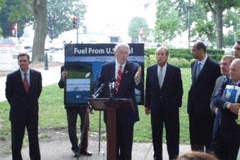
Senator Jim Bunning discusses moving the 'Coal-To-Liquid Fuel Promotion Act of 2006' forward at a liquid coal press conference. (Courtesy of U.S. House of Representatives)
WARD: Everybody wants to be the first person to build the fifth plant.
YOUNG: That’s John Ward, he’s with an energy development company called Headwaters Energy. Ward’s been making the rounds in Washington pitching liquid coal to lawmakers. He can also tell the fuel’s curious history. It starts with two German scientists early in the 20th century.
WARD: This is kind of the Saturday Night Live joke: it’s Hans and Franz-- they were behind the first development of a catalyst.
YOUNG: Hans and Franz Fuel would have had a pretty nice ring to it. Unfortunately, the catalyst they invented went by their last names—Fischer and Tropsch. It turned coal into a liquid that could be refined into gasoline, diesel or aviation fuel. And Germany found a use for that in the 1940s.
[GERMAN NEWS REAL OF TANKS AND PATRIOTIC MUSIC]
YOUNG: World War 2 allied forces cut Germany’s oil supply. So Nazis kept their war machine running on liquid coal. After the war the fuel fell out of favor except in South Africa. South Africa had lots of coal, very little oil, and reason to worry that it could be cut off from the world’s petroleum trade.
BOTHA: Destroy white South Africa and this country will drift in faction strife, chaos, and poverty.
YOUNG: That was P.W. Botha, one of the last and most defiant leaders of South Africa’s apartheid government. Facing an international trade embargo South Africa invested heavily in coal to liquid refineries. Long after apartheid rule passed, South Africa’s energy company Sassol remains a world leader. John Ward says the industry takes root in countries with a strong interest in developing domestic fuels.
WARD: In both Germany and South Africa it was because they lost access to liquid fuels from other parts of the world and that’s exactly the same situation that faces the U.S. today. People are interested in doing coal to liquids here because we’re tired of sending trillions of dollars to countries who don’t particularly like us and be able to seize the initiative and create an industry that uses an American resource and creates American jobs to provide a more dependable source of liquid fuels.
YOUNG: The U.S. has been down this road before. If you remember bell-bottoms and disco, you probably also remember this.
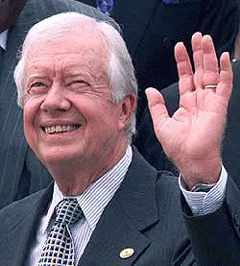
Former U.S. President Jimmy Carter. (Courtesy of U.S. Embassy- Uruguay)
CARTER: Good evening, tonight I want to have an unpleasant talk with you, about a problem that’s unprecedented in our history. With the exception of preventing war, this is the greatest challenge that our country will face during our lifetime. The energy crisis is not yet on the front of the list, but it will be if we do not act quickly.
YOUNG: During the energy crisis of the 1970’s President Jimmy Carter pumped billions into liquid coal.
CARTER: We can protect ourselves from uncertain supplies by reducing our demand for oil, by making the most of our abundant resources such as coal.
YOUNG: A few demonstration projects were built, but the country ended up with little to show for its money. When the oil rich nations of OPEC let more oil flow, prices dropped and industry lost interest in oil alternatives. So what should we learn from this liquid coal history? Industry booster John Ward says it teaches us that we need to support alternative fuels against market manipulation by the oil cartels.
WARD: That’s an appropriate national security role for the federal government to step in and provide conditions that allow this industry to get started on a fair footing.

Coal train (Courtesy of the State of Indiana)
YOUNG: But Phil Clapp of the National Environmental Trust sees a different lesson.
CLAPP: This is the resurrection of Jimmy Carter’s ill-fated synthetic fuels program- all you ended up with was kind of a taxpayer rip-off. This is not something that’s ever survived in the marketplace and it’s only governments dumping big amounts of money into it.
YOUNG: Some in Congress share Clapp’s concerns about cost and climate. They also worry that liquid coal would undercut other alternative fuels like ethanol from cellulose. But the White House included liquid coal in a recent proposal on alternative fuels. And supporters like New Mexico’s Republican Senator Pete Domenici are confident it will get help from Washington.
DOMENCI: Coal to liquids will happen. I don’t think you can stop it. For those who are opposed to it they better get their shields up.
YOUNG: Whatever the U.S. does it looks like liquid coal is expanding elsewhere. China is building new facilities in its coal producing regions.
[MUSIC: Jenny Wilson “Would I Play With My Band” from ‘Love & Youth’ (Rabid Records – 2006)]
Related links:
- PRO liquid coal: Coal-to-Liquids Coalition
- ANTI liquid coal: Natural Resources Defense Council
Biofueling Deforestation
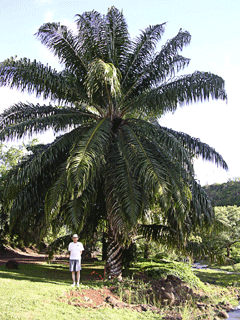
An oil palm tree, an important source of biofuel. (Courtesy of U.S. DOE Genome Programs)
YOUNG: There’s no silver bullet in the search to replace oil. Biofuels are also booming—things like ethanol from corn and sugar cane, and diesel derived from palm oil, are attracting interest and investment worldwide. The European Union has set an ambitious target: to replace nearly six percent of petroleum with biofuels in just the next three years.
That will take a lot of plants, and a lot of cropland that Europe simply does not have. So the E.U. is looking to the developing world, particularly Southeast Asia. That’s where Fred Stolle is keeping an eye on forests for the World Resources Institute. Stolle says Europe’s appetite for biofuel could take a big bite out of the region’s forests.
STOLLE: You would need around three million acres of biodiesel to replace one percent of the needs of the European Union. Probably that crop would come from Southeast Asia and mainly at the moment I would say Malaysia and Indonesia, oil palm, which is the main favorite crop for exchanging biodiesel.
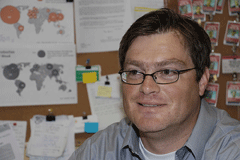
Dr. Fred Stolle Program Manager Forest Landscapes in Southeast Asia World Resources Institute's People and Ecosystems Program (Photo: World Resources Institute)
YOUNG: Hmm. Oil palm from Malaysia and Indonesia. Is that a good thing for those countries?
STOLLE: Well, it’s a mixed bag. It could be a good thing if you think about how many people could work in those plantations. The development for those countries, I mean they might be the new OPEC countries of the future. But, it could be devastating for the environment if not done right.
YOUNG: Why’s that?
STOLLE: Well, you make oil palm plantation, at the moment on tropical rainforest. You have to cut the forest. You have to burn the forest. It’s got a lot of CO2 emissions. And also on the side of all kinds of biological functions you might go wrong.
YOUNG: And what makes it especially good for a biofuel?
STOLLE: Well, it has a high energy content. So, of you compare let’s say the three big crops everybody is talking about. There is sugar cane, and that has just the highest rate of return on energy. Oil palm follows directly behind it. It’s also very high contents of energy matter. Unfortunately corn has a very low energy output.

An oil palm tree, an important source of biofuel (Courtesy of U.S. DOE Genome Programs)
YOUNG: Part of why people are so hot for biofuels these days is the idea that we need to reduce our carbon dioxide emissions from the fuels that we burn. If we are using biofuels are we sure that we’re really helping on the global warming equation there or not?
STOLLE: Again sorry to say it’s a mixed bag. Yes, if you think about there’s now a grassland that’s in Indonesia and you put an oil palm plantation there and you store more carbon it will be really beneficial. But in the same way if you would make those plantations on a peat swamp forest you burn the peat swamp, you burn the forest you put a plantation that you actually increase climate change you have a lot of emission from carbon. In Indonesia they have the biggest peat swamps in the world and these peat swamps are 30-40 feet thick. And it’s all carbon. And so if you burn that it would be an enormous emission of carbon would give that. And that’s very detrimental for climate change.
YOUNG: So where do you see things going? Are you hopeful that we’re going to get a grip on things and make biofuels work the way we want them to, or are you worried that biofuels might backfire?
STOLLE: I am of a positive attitude. I think it will be a great asset. We can really reduce our carbon emissions so it will be good for climate change. And I think that many countries really could benefit from it also I mean, a lot of countries could diversify their energy needs. You don’t have to go to the OPEC countries only you can go to other countries to substitute part of your energy. But I think the key thing is to be sure that the certification issues are sorted out. That countries really plan ahead, they make sure it’s not many of these plantations come not from forest as it is now. And really make sure that a new there is all kind of safe guards and also countries who buy those biofuels look at those safeguards and only buy it when certain of those safeguards are in order.
YOUNG: Mmm hmm and again, we’re not just talking about Indonesia and Malaysia and pointing our fingers at them we’re saying hey, the wealthy consumer nations have a responsibility here too.
STOLLE: They definitely have a responsibility. I mean they, in the end, buy most of these products so if they don’t demand it then why would a country make the effort to do it? So in the end it is a big responsibility on this side, on the Western countries to say yes we really like biofuels but we only like biofuels if several of these criteria are met.
YOUNG: Thanks again for joining us.
STOLLE: Thank you for having me.
YOUNG: Fred Stolle monitors forests for the World Resources Institute. You can find more on the challenges of biofuels and liquid coal at loe.org.
[MUSIC: Trespassers William “Eyes Like Bottles” from ‘Having’ (Nettwerk - 2006)]
Related links:
- U.S. Department of Energy Genome Programs
- World Resources Institute Home Page
- Ecologistas en Acción
- To view the report on the Impacts of Agrofuels click here.
YOUNG: Coming up: modern genetics and patent law pose a fundamental philosophical challenge: who owns life? Keep listening to Living on Earth.
[MUSIC: Clogs “Medley” from ‘Lantern’ (Brassland - 2006)]
Genes For Sale
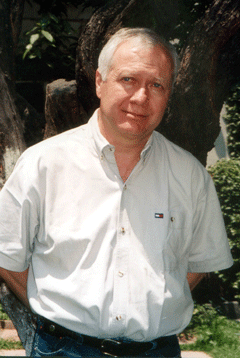
Pat Mooney (Photo: ETC Group)
YOUNG: It’s Living on Earth. I’m Jeff Young. For the last few weeks, we’ve been marking the sixteenth anniversary of our program by revisiting and updating some of the award-winning stories from our archives. For the final installment of our series, we’re pointing the way back machine to 1994, one of the first reports to highlight concerns about what was then a new practice; claiming ownership of genetic material—in particular, the DNA of human beings.
Reporter Bob Carty, of the Canadian Broadcasting Corporation, explored the tale of a human cell line from a group of Panamanian Indians, on which the United States Government had taken out a patent. The story raised the fundamental question of “who owns life” and it won an Edward R. Murrow Award from the Radio and Television News Directors Association.
We’ll take a listen to that story now, and afterwards we’ll catch up with the Canadian activist who was among the first to draw attention to the practice of patenting human genes. Here’s Bob Carty.
[SOUND OF VAPOR HISSING]
CARTY: In a large basement room in Rockville, Maryland, white vapor hisses from hoses as they charge eight steel tanks with liquid nitrogen. Inside the tanks, at 211 degrees below zero, are tiny glass vials, one and a half million of them. Each vial contains a little piece of life: of bacteria, viruses, fungi, plants, animals, and human beings. This is the American Type Culture Collection, or ATCC. The ATCC is a complex of three buildings with heavy security doors. Inside, the atmosphere is a curious mix between a library and a distribution warehouse. The ATCC does a bit of both. In part it's a cell library, where scientists deposit genetic material as a requirement of the patent process. The ATCC also sells cloned samples of that material to other researchers. The ATCC even has a catalogue on computer disk. That's how a Canadian researcher first came across evidence of genetic prospecting. The researcher was Pat Mooney, the director of a biodiversity research organization called The Rural Advancement Foundation International. One day last summer, Pat Mooney was browsing through the ATCC catalogue on his home computer in Winnipeg, Manitoba. He was hoping to find something about seeds in Asia, but he stumbled on something else.
(SOUND OF TYPING ON COMPUTER)
MOONEY: I was really trying to track something down related to India, so I typed in "India" and was trying to do a word search through it that way. And suddenly on my screen, one of the options that popped up was a Guaymi Indian Woman from Panama. Which was not what I was looking for. As I read through it, I could see that they were saying that they had the human cell line and that for the low, low sum of $127 I could have my own Guaymi Indian Woman from Panama in my own little test tube. I didn't know what to say; I was stunned. To me it was just an incredible thought that you could do something like that.
CARTY: At the time, Pat Mooney didn't know what to do with that odd piece of information. But a couple of weeks later, he was looking at a different computerized database, one that lists applications for patents in Europe. He typed in the word "Guaymi."
(TYPING)
MOONEY: And suddenly there she was on the screen. The patent application. The title of the patent was Guaymi Indians from Panama, and to me the most astonishing aspect of all of this was that the assignee for this patent, the one who was applying for the patent, was the Secretary of the Department of Commerce of the United States government. And how is it that someone who is the head of a major government department of the United States, on behalf of the United States, is claiming the human cell line of not just an indigenous person but the citizen of a foreign country?
CARTY: The foreign country was Panama, where in the western rainforests 124,000 Guaymi native people live. It all goes back to the 1980s, when the genetic revolution was taking off. Scientists became interested in aboriginal people because, as isolated populations, they might have a few unique genes or cells. And such cells or genes could make drugs that could be worth billions. Researchers had already discovered something special about the Guaymi. Many of them carried a kind of retrovirus which, at the time, was thought to be associated with the viruses that cause leukemia and AIDS.
In 1990 some American doctors went to the jungles of western Panama. They took blood samples, including one from a 26-year-old Guaymi mother of two. The researchers say they do not know her name. Back in the United States, they took one of the woman's cells and cloned it, duplicated it hundreds of times. That's called a cell line, and the U.S. Department of Commerce put a patent claim on it. One of the researchers was Dr. Jonathan Kaplan from the U.S. Centers for Disease Control in Atlanta.
KAPLAN: When you work for the government, the government encourages people who develop things like that to apply for a patent. If there is money to be made, the vast majority of it comes right back to the government. There was really no thinking about individual motives or profits.
CARTY: Dr. Kaplan's motives may not have been financial, but the U.S. government clearly considered the Guaymi cells of potential value: a possible windfall for the government itself, or something it could sell to private biotech companies. Meanwhile, Pat Mooney, the Winnipeg researcher, had established contact with leaders of the Guaymi people. They were shocked when he told them they were being used as genetic raw material. From Panama City, I reached Jose Acosta, a Guaymi and a consultant to the Guaymi National Congress.
ACOSTA: (Speaking in Spanish)
TRANSLATOR: When the Spanish arrived in 1492, they took away our gold. When the countries of Latin America became independent, they stole our land. Today, the same thing is happening. They want to take our cells. The exploitation is still going on.
CARTY: What most outraged the Guaymi was that they were never consulted. The researchers claim that they did tell the Guaymi, in general, that they were the subject of medical studies. But there is an obvious pitfall here. Many Guaymi are illiterate. Many don't even speak Spanish. And in their language, there's no word for "genetics." Dr. Jonathan Kaplan concedes that the Guaymi were not given the full picture.
KAPLAN: I think most people wouldn't understand all the details of all the laboratory work that was being done. So in terms of specifically, um, notifying the Guaymi that a patent application was being put forth, I don't believe that was done. But again, mainly because I don't think anyone felt it was really necessary. No one was trying to dishonor them or to take anything from them in any way.
CARTY: But the Guaymi say something was taken from them. They call it theft. They say that if their bodies contain something that can benefit humanity, they are not against sharing it. But they want to have control over the disposition of their genes. And they resent scientists who are willing to spend so much money to preserve the Guaymi and their genetic history in a test tube, while there are so few resources to help the Guaymi survive as a people. Guaymi spokesperson Jose Acosta.
ACOSTA: (Speaking in Spanish)
TRANSLATOR: We are not opposed to sharing with humanity. What we oppose is being exploited where our poverty is not resolved. We have looked into this biotechnology work. To process a sample, the cost per person is $2,300, while the rural salary of a Guaymi is less than $80 a year.
CARTY: The Guaymi sent letters to the U.S. government demanding the patent application be dropped. With the help of Pat Mooney's organization, they took the issue to the United Nations. Then, last November, the U.S. government withdrew its patent application. Officials contend it was not because of the protests. They say there was just not enough commercial interest in the cell line to continue the patent process. That may be true. But it suggests that if the Guaymi woman had something more valuable in her cells, the U.S. government would still be trying to slap a patent on them. The U.S. government still claims ownership of the cell line. It won't be returned to Panama, as the Guaymi have requested. It's still for sale at the American Type Culture Collection.
(TANKS BEING CHARGED WITH LIQUID NITROGEN)
CARTY: Human material is one of the fastest-growing collections at the ATCC. And this is just one of hundreds of cell libraries around the world. Many are private and restricted. Pat Mooney contends that private biotech companies are engaged in a gold rush for genes that researchers have yet to uncover.
MOONEY: What we've seen in Panama was the beginning of this. Just the tip of the iceberg. We’ve discovered two more examples of patent claims by the U.S. government again, against the lives, the human cell lines of people in Papua New Guinea, and the Solomon Islands. This is bio-piracy.

Pat Mooney (Photo: ETC Group)
CARTY: And it's not just an issue for the Third World. A Swedish pharmaceutical company recently secured a patent on a gene from the people of an isolated village in Italy. The company may soon be marketing drugs from the gene to treat heart disease. Meanwhile, native groups in Canada and Australia have joined those in Latin America in calling for a halt to gene prospecting. For the biotechnology companies, that's an alarming prospect. Charles Ludlum is Vice President of the Biotechnology Industry Organization, a Washington lobby. Ludlum agrees that gene research should be conducted with prior, informed consent. But he argues that patenting other people's genes and cells is necessary to compensate the biotech industry for its costly investments.
LUDLUM: I don't think there is any ethical question involved with trying to create medicines that help human beings to avoid suffering and to avoid death. I think we need to go wherever medical knowledge can be found; and if we find that there is an aboriginal group that has a special propensity to have a disease, or a special immunity to a disease, then I hope that they would be willing to share that with the rest of the world so that all of us can benefit.
CARTY: But biotechnology critics don't trust the industry. Andrew Kimbrell is the author of The Human Body Shop: The Engineering and Marketing of Life. He argues that to control and regulate gene research and patenting, we need new international treaties. Such treaties might guarantee indigenous groups a share in the commercial returns from their genes. Kimbrell maintains that genes should not be private property, but rather a public heritage for all humanity.
KIMBRELL: I think what we are seeing, increasingly around the world, is an enclosure of the genetic commons; and we're in an extraordinary situation where I think in a very short time, we're going to see all of the 100,000 or more human genes owned by a few companies.
[CELL VIALS BEING SCATTERED]
CARTY: At the ATCC cell library in Rockville, Maryland, a worker is counting out tiny glass vials, packaging them up for sale: little pieces of the living world, and ever more frequently, little pieces of ourselves. There are almost no rules to govern this new commerce in the little parts of us. Governments and the international community are just starting to debate the issue. Back in Winnipeg, Pat Mooney insists there is a philosophical, question our society has yet to grapple with.
MOONEY: Patents were meant for sewing machines; now they're being applied to Guaymi people in Panama. We have a new kind of an industry out there. We no longer have a food industry or a pharmaceutical industry or a chemicals industry per se; we really have a life industry. And the thought that someone could have exclusive monopoly control for 17 years over the products, the processes, and in fact even the formula of life, is a scary thought. The fundamental question is who owns life?
CARTY: For Living on Earth, I'm Bob Carty.
YOUNG: Well, that story from the Living on Earth archives in 1994. We caught up with one of reporter Bob Carty’s sources for that story, Pat Mooney. He’s now the executive director of the Etcetera Group, a Canadian watchdog organization that tracks international issues of property rights surrounding genetic material and nanotechnology. Pat, welcome back to Living on Earth.
MOONEY: Thanks Jeff, nice to be here.
YOUNG: Now you were one of the first people to start raising concerns about these issues. That was more than a decade ago and so much as changed in the intervening time in genetics. Have the rules regarding patenting kept pace with the technology?
MOONEY: Not at all. I think governments are still grappling with- and certainly the medical research community is still grappling with- how to handle these kinds of issues. Meanwhile the patents have continued and moved down in a sense that we’ve moved from just patenting life to patenting the building blocks of life; the basic atoms and molecules that make up the DNA that make up the genes that make up everything else. The technology has certainly rapidly moved ahead. And moved very deeply into indigenous communities around the world, well beyond what we thought back in 1994. And governments are still scratching their heads.
YOUNG: We heard some fairly dire predictions in the story there that the genes of life, for human beings, would be owned by a few companies. Has that come to pass?
MOONEY: Yes it has as best as we know it. And it’s harder to track down the information. I guess one of the areas that has developed more in the last few years is in the ability of companies and patent offices to be obscure about what actually is being done. We no longer clearly see written on the titles of patents Guaymi woman from Panama, Hagahai man from Papua New Guinea. And we see the controls, the visible controls, falling into the hands of a hand full of companies. Of the 24,000 or so genes that we now know are part of our nature about a little bit under 5,000 have clear patents on them already. Of those probably basically three enterprises control about 60 percent of the genes we know to be patented.
YOUNG: You know, um, on the other hand, you know, there’s such promise for good to society from nanotechnology and genetics. You have to have some way to motivate people to do the intensive and expensive research. And that’s what a patent is supposed to do right? So if we don’t have patenting how do we encourage the sort of research that we need, we desire to have done?
MOONEY: Well, you’re right. We do want to encourage innovation. But I think most people who look in this field now would have to agree that patents are really a barrier to innovation. They’re a barrier for entry for new companies coming into the market place because patents are there to blockade a technology, keep everybody out of that field. And the cost of patents, and the litigation around patents is so high, it’s so expensive that only the biggest players can really get into the act to duke it out in the courts to protect their patent interest. What we need to have is an innovation system which certainly rewards creativity, encourages dissemination of that creativity and guarantees that there’s some equitability and access to it as well. And that can be done I think without giving exclusive monopoly to those who weren’t the inventors. They shouldn’t be able to set all the conditions of sale and vary the conditions of sale for their patented products from one customer to another.
YOUNG: Well, this is fascinating. There are so many things here that you’re keeping tabs on. I’m wondering, of all these things that we’ve talked about here is there one that you put at the top of your list of concerns?
MOONEY: Can I give two? There are two very specific claims in this field that we find quite scary. One of them is one that Monsanto has where it’s claimed the species of soybeans. Any biotech work on the crop of soybeans anywhere in the world is a violation of Monsanto’s patent. The idea that you can actually own an entire species of a major crop is simply outrageous.
The second example I give is one by Syngenta, one of the other big company’s based in Switzerland, Syngenta has actually got a claim on how a plant flowers. So it’s actually the strip of DNA that allows a plant to flower. Ant it’s said that this claim applies to 40 different species in the food system including rice and wheat, bananas and so on. So if Syngenta’s patent claim is ever accepted, Syngenta would own the world’s food supply basically all by itself. We think that if the company got the patent they’d be forced to back off. I think there’d be something of a revolution before that patent would be allowed to be implemented. But it shows the failures of the patent system and the inability of governments to address the questions who owns life and who owns nature.
YOUNG: Is that still the right question? That was the question posed in 1994 in that story, Who Owns Life, are we still asking that question?
MOONEY: We’re asking it, but we’re, again, it’s become more fundamental than that. It’s not just life, it is the nature that builds life. In this field of synthetic biology or nano-biotechnology we’re now seeing patent claims again that are on the building blocks of life. And that’s the scariest thing of all because they’re below the radar screen of politicians and policy makers of any kind because they don’t seem to be consequential and then the patent is granted and suddenly you realize that you’ve given away the Garden of Eden.
YOUNG: Pat Mooney still tracking the question “who owns life”- a question that seems to get more complex as time goes on. Thank you very much for joining us.
MOONEY: Thanks for having me.
YOUNG: Well, you can find a link to Pat Mooney’s Etcetera Group and other resources on the question of who owns life at loe dot org.
[MUSIC: Amon Tobin “Straight Psyche” from ‘Foley Room’ (Ninja Tune – 2007)]
Related link:
ETC Group
YOUNG: Coming up the sounds of cicadas and other insects inspire a new symphony. That’s just ahead on Living on Earth.
ANNOUNCER: Support for Living on Earth comes from the Cedar Tree Foundation and from the Richard and Rhoda Goldman Fund. Celebrating the 2007 Goldman environmental prize winners. Learn more about each winner at www.goldmanprize.org. This is Living on Earth on PRI, Public Radio International.
[MUSIC: Erik Friedlander “Airstream Envy” from ‘Title TBA’ (Brassland - 2006)]
Pollinator Problems
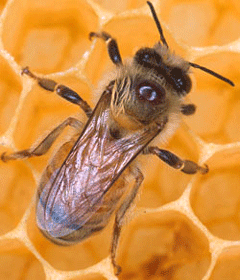
A honeybee (Courtesy of NIH)
YOUNG: It’s Living on Earth. I’m Jeff Young. It’s planting season around much of North America. And before long, crops all over the continent will need swarms of honeybees to pollinate the flowers so they can produce about a third of our food. But as we recently reported, those swarms are getting smaller. Roughly a quarter of America’s 2.4 million honeybee colonies have been lost in recent months. Honeybees are in trouble both here and abroad and no one knows exactly why.
This past week brought a summit on what’s come to be called Colony Collapse Disorder. Keith Delaplane was part of that discussion. He’s an Entomologist at the University of Georgia and Senior Editor of the Journal of Apicultural Research. Professor Delaplane says the meeting was the first real opportunity for experts from around the U.S. to compare the latest findings on the honeybee problem.
DELAPLANE: The common thread was to try to get a handle on the reality and the extent of colony deaths. And also there’s a real interest in trying to identify possible causes and their interactions. And then finally draft a list of research priorities that could be fundable and researchable and try to get some real answers.
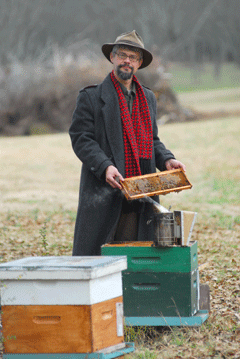
Keith Delaplane with his honeybees. (Courtesy of Keith S. Delaplane)
DELAPLANE: We have a good idea of potential causes. In fact most of them are old things that we’re familiar with from years of honeybee problems. A lot of this goes back to the 1980s when there were exotic honey bee parasites that came to our shores, a couple of parasitic mites.
YOUNG: So it might be the mites?
DELAPLANE: It might be the mites. I’m pretty sure it’s the mites. But there’s other things too. And there’s other disease-causing agents some of which are not even possibly identified or understood. And there’s other management factors that certainly play a negative role. It’s helpful to remember that commercial bee keeping is rough. It’s rough on the beekeeper, it’s rough on the bees. They’re loaded on trucks in the middle of the night. They’re trucked miles and miles from coast to coast and this is stressful on the bees.
YOUNG: Huh, so over-worked honey bees. Is that what you’re talking about?
DELAPLANE: It’s possible to over-work even the busy bee.
YOUNG: (laughs) And so they’re moving them all around, that’s not necessarily causing them to die but it’s stressing them and making them more vulnerable.
DELAPLANE: Exactly. We have evidence that when you add a succession of stresses onto the honeybee colony it takes very little additional stress to tip a colony over the top. You have one parasite that’s bad. You have another parasite that’s bad. Let’s add a disease, a pathogen, let’s add poor nutrition. Now let’s load it on a truck and move it in the middle of the night, maybe we shouldn’t be surprised that some of these colonies are dying.

A honeybee (Courtesy of NIH)
YOUNG: So what about pesticides or other chemical toxins?
DELAPLANE: Pesticides are an age-old enemy of bee keeping. Fortunately the classes of chemicals that are used in recent years tend to be less acutely toxic. So we’re not seeing large dramatic bee kills like we were accustomed to in the 1960s and 70s. That’s the good news. The bad news is a lot of the new chemistry that we’re using has more subtle sub-lethal effects that are still there but hard to detect. The best example of this is some new classes of chemistry that impairs the bee’s cognitive ability. When it comes to honey bee’s cognitive ability one of the most important things is your ability to find your nest. If you’re out flying, visiting flowers can you find your home again? And a lot of these new chemicals do impair the bee’s ability to return to their nest and this is subtle. It’s very easy to overlook. And what the beekeeper sees is just a dwindling colony population.
YOUNG: And I understand that, aside from this new phenomena, pollinators in general haven’t been doing very well.
DELAPLANE: This is a systemic problem that transcends bee keeping and honey production. It also involves more than honeybees. Because we have in general an increasing acreage of pollinated crops at the same time that we’re have a decrease in the density of our pollinators. And this is creating a pollinator deficit that is of broad societal concern. Cause, literally the quality of diet that we enjoy in the developed world are very largely dependent of bee-pollinated plants.
YOUNG: Are we asking too much of the honeybee here? Should we be looking at other possible pollinators to help out if the honeybee is hurting?
DELAPLANE: I fully agree with that. We have a large number of native bee species here in North America. Most of them are overshadowed by the honeybee, which is by the way an alien species, it was imported here from Europe in the 1600s. But these native, solitary, and bumblebees that exist here in North America are themselves important contributors to our food supply and the pollination chain. Our knowledge of them has lagged behind our knowledge of the honeybee simply because they are not as manageable and therefore not as easy to study.
YOUNG: Now you mentioned the bumblebee as a possible back up, the plan B. What about other insects, other animals all together that pollinate. Are they options?
DELAPLANE: Surely there’s plenty of other animals that visit flowers. And any animal that visits a flower, including some physical forces like rain and gravity, all of these are viable pollen vectors. The reason bees in general sort of rise to the top on these lists is the fact that they are extremely efficient at what they do. They’re basically flying fuzz balls, and the pollen sticks to their bodies very readily. They have a natural affinity for flowers, where as a lot of insects just visit them accidentally. So yes, other pollinators are viable and certainly to be encouraged but nothing will ever replace bees.
YOUNG: Professor Keith Delaplane thank you very much for speaking with us.
DELAPLANE: Thank you for having me.
Related links:
- Mid-Atlantic Apiculture Research and Extension Consortium
- Keith Delaplane's Website
YOUNG: Keith Delaplane is a professor of Entomology at the University of Georgia. He took part in that recent summit on the crisis facing America’s vital honeybee colonies. There’s much more about pollinator problems and ways to be part of a solution at loe.org. Just ahead, other flying insects inspire a new symphony. But First…
[MUSIC: Daniel Lanois “O Marie (HomeGrown Theme)” from ‘Acadie’ (Daniel Lanois – 2005)]
The Language of Landscape
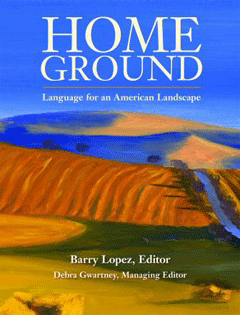
Home Ground: Language for an American Landscape, edited by Barry Lopez and Debra Gwartney. (Courtesy of Trinity University Press)
YOUNG: There are places in the American landscape that are unlike anywhere else in the world, places that stand out, grab the memory like no other. We’ve been chronicling some of these unique natural features in our periodic series: Home Ground: Language for an American Landscape. This week, writer Eva Saulitis brings us her definition of a rare … and sometimes exciting phenomenon known as the Tidal Bore.
SAULITIS: Tidal bore. A term coined by seamen around 1600, tidal bore describes a violent wall of water rushing up a shallow narrowing river, estuary, or bay. Bores, also called bore tides, form when an incoming tide meets a particular geography a resistance: sand, silt bars, narrowing channels and heaps water up to 15 feet high moving inland at 10 to 15 miles per hour.
[MUSIC: Adam Snider “The Anger of God” from ‘Berkeley Guitar’ (Tompkins Square – 2006)]
Most bores build after low water of a spring tide, the year’s biggest tidal flux. Famous bore tides occur in the Truro River in Canada’s Bay of Fundy and at Turnagain Arm in Alaska’s Cook Inlet. The latter driven by a tidal rise of 30 feet in six hours.

Home Ground: Language for an American Landscape, edited by Barry Lopez and Debra Gwartney. (Courtesy of Trinity University Press)
In summer, travelers driving along Turnigain Arm can witness wind surfers bundled in dry suits dancing along the waves face. Their brightly colored sails a dramatic contrast to the gray silty inlet. When it surges up the lower Amazon the bore, pororoca can shave forests and destroy homes. It is greatly feared by locals yet ridden by elite surfers from around the world.
YOUNG: Eva Saulitis is a writer, teacher and marine biologist from Homer, Alaska. Her definition of “Tidal Bore” appears in the book Home Ground: Language for an American Landscape edited by Barry Lopez and Debra Gwartney.
[MUSIC: Adam Snider “The Anger of God” from ‘Berkeley Guitar’ (Tompkins Square – 2006)]
Related link:
Home Ground: Language for an American Landscape
Living, Breathing Earth
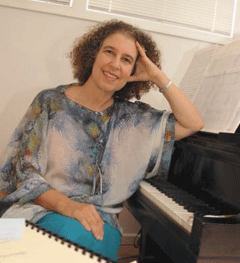
Meira Warshauer (Courtesy of Meira Warshauer)
YOUNG: The layered sounds of insects on a warm late spring evening have often been compared to a symphony. Well, now they really are. Composer Meira Warshauer’s first symphony was inspired by the sounds she heard in the rainforest of Peru, and in her own backyard in South Carolina. And it just had it’s debut performance by the Dayton Philharmonic Producer Aileen LeBlanc has this profile of the composer and her new work: called "Living Breathing Earth."
[SOUND OF CICADAS ]
WARSHAUER: I had been recording the cicadas and the backyard sounds and was listening really carefully to them I wanted to see what were the natural rhythms – what were the sounds that were around us. I was playing those over and over again the recordings of the cicadas and the birds and the water and the rhythmus of the cicadas really caught my ear. They have like a 21 second or so span or phrase – on the shaker it goes like….
[SHAKER AS CICADA]
Warshauer: Or with my mouth it’s just…
[MOUTH AS CICADA]
WARSHAUER: I was interested in the shape of that phrase - how it starts slowly and gets faster and then builds to the crescendo and then it has this glissando at the end. So I took that length and that kind of the energy rising and the minuendoing getting softer and let that be the arch of the phrasing of the first movement which is called The Call of the Cicadas.
[MUSIC: Meira Warshauer “Living Breathing Earth (various selections)” from ‘South Carolina Philharmonic (conducted by Nicholas Smith)’ (Engineered by Jeff Francis – 2007)]
WARSHAUER: Actually I asked myself – “What would Mr. Cicada do? What would he sound like if he had a whole orchestra like I have to play?” It wouldn’t just be high pitches and it wouldn’t just be those rhythms. What would it be? It certainly would be a broader pitch range from low to high and so I was able to bring in the bases and the low brass and. But I also wanted to give a sense of the summer air and the humidity and the thickness of that summer heat and so I had the oboes and bassoons.

Meira Warshauer (Courtesy of Meira Warshauer)
[MOUTH AS MOSQUITOS]
[MUSIC: Meira Warshauer “Living Breathing Earth (various selections)” from ‘South Carolina Philharmonic (conducted by Nicholas Smith)’ (Engineered by Jeff Francis – 2007)]
WARSHAUER: Maybe it’s a mosquito, I don’t know but its one of those insects that kind of comes out when it’s really hot in the south and I associate it with this really thick wonderful hot air which I love - I’m from North Carolina and I love the summer heat.
The recordings in Peru were not as dramatic as the ones I had in my backyard. But what those recordings have is a richness of layers - so many different animals making their quiet contributions to an incredibly rich soundscape.
[MUSIC: Meira Warshauer “Living Breathing Earth (various selections)” from ‘South Carolina Philharmonic (conducted by Nicholas Smith)’ (Engineered by Jeff Francis – 2007)]
WARSHAUER: My family and I, when we went to Peru we stayed in a lodge right on the Tahuayo River and one night we went on a canoe ride down this the Tahuayo River. And it was a night with no moon – so all the stars were really bright –and not only the stars were twinkling in their dark background but along the sides were the fireflies. So we had the stars twinkling and then the fireflies connecting the heavens really to the earth and then since we were on the river it didn’t stop at the earth because it was it was all reflected in the dark water below and it was so peaceful.
[MUSIC: Meira Warshauer “Living Breathing Earth (various selections)” from ‘South Carolina Philharmonic (conducted by Nicholas Smith)’ (Engineered by Jeff Francis – 2007)]
WARSHAUER: The third movement captures the energy of the butterflies as they are swirling around. By the side of the river there were these yellow butterflies that were in a pattern and of course the sun was shining on them and lighting up the water glistening there and it was really, um, kind of sparkly sounding and I put it in the strings and just had them move really fast and very lightly.
So I mean I hate to proselytize but, in this time, I feel it’s so important for us to reconnect with how much we love this earth. I know everyone loves the earth. Who’s ever seen a child that doesn’t love to play outside?
[MUSIC: Meira Warshauer “Living Breathing Earth (various selections)” from ‘South Carolina Philharmonic (conducted by Nicholas Smith)’ (Engineered by Jeff Francis – 2007)]
WARSHAUER: We all come into life loving the earth and we need to wake up. So I hope this wakes us up. I hope it gives us comfort. I hope it gives us joy. I hope it lulls us to sleep in the second movement. I hope it wakes us up with wings in the third movement. I hope the first movement just make us want to go outside and listen to all the weird and great stuff that there is and I hope the last movement just inspires us and carries us forward.
[MUSIC: Meira Warshauer “Living Breathing Earth (various selections)” from ‘South Carolina Philharmonic (conducted by Nicholas Smith)’ (Engineered by Jeff Francis – 2007)]
YOUNG: Meira Warshauer’s new symphony “Living Breathing Earth” was commissioned by the Dayton and South Carolina Philharmonic Orchestras and the Western Piedmont Symphony. We heard the South Carolina Philharmonic, conducted by Nicholas Smith, and recorded by engineer Jeff Francis. And our piece was produced by Aileen LeBlanc.
[MUSIC: Meira Warshauer “Living Breathing Earth (various selections)” from ‘South Carolina Philharmonic (conducted by Nicholas Smith)’ (Engineered by Jeff Francis – 2007)]
Related links:
- Meira Warshauer's website
- "Music & Vision Daily" interview with Meira Warshauer
YOUNG: Next week on Living on Earth thirteen years ago, Hammerskjoeld Simwinga set out to preserve the elephant population in his native Zambia by helping to create economic alternatives to poaching. Now he’s won the 2007 Goldman Environmental Prize for Africa.
SIMWINGA: To me, I believe to each continent God gave its own habitation. Elephants—they are part of our blood. So if they are not there, then the continent is not there.
YOUNG: Saving elephants and people in Zambia next time, on Living on Earth.
YOUNG: We leave you, this week, with the sounds that inspired the “Living Breathing Earth” Symphony.
[“Back Yard Symphony (Cicadas & Crickets)” recorded by Meira Warshauer for ‘Living Breathing Earth’ (South Carolina - 2006)]
YOUNG: Composer Meira Warshauer recorded these sounds of the night in her backyard in South Carolina.
[“Back Yard Symphony (Cicadas & Crickets)” recorded by Meira Warshauer for ‘Living Breathing Earth’ (South Carolina - 2006)]
YOUNG: Living on Earth is produced by the World Media Foundation. Our crew includes Ashley Ahearn, Eileen Bolinsky, Bruce Gellerman, Ian Gray, Ingrid Lobet, Jennifer Percy, Emily Taylor and Peter Thomson - with help from Bobby Bascomb and Kelley Cronin. Our interns are Paige Doughty and Meghan Vigeant. Dennis Foley is our technical director. Alison Lirish Dean composed our themes. And our executive producer is Steve Curwood. You can find us at loe dot org. I’m Jeff Young. Thanks for listening.
ANNOUNCER: Funding for Living on Earth comes from the National Science Foundation, supporting coverage of emerging science; And Stonyfield Farm Organic yogurt, smoothies, and milk. Ten percent of profits are donated to efforts that help protect and restore the earth. Details at Stonyfield dot com.
Support also comes from you our listeners, the Ford Foundation, the Town Creek Foundation, and the Saunders Hotel Group of Boston's Lennox and Copley Square Hotels. Serving you and the environment while helping preserve the past and protect the future, 800-225-7676.
Living on Earth wants to hear from you!
Living on Earth
62 Calef Highway, Suite 212
Lee, NH 03861
Telephone: 617-287-4121
E-mail: comments@loe.org
Newsletter [Click here]
Donate to Living on Earth!
Living on Earth is an independent media program and relies entirely on contributions from listeners and institutions supporting public service. Please donate now to preserve an independent environmental voice.
NewsletterLiving on Earth offers a weekly delivery of the show's rundown to your mailbox. Sign up for our newsletter today!
 Sailors For The Sea: Be the change you want to sea.
Sailors For The Sea: Be the change you want to sea.
 The Grantham Foundation for the Protection of the Environment: Committed to protecting and improving the health of the global environment.
The Grantham Foundation for the Protection of the Environment: Committed to protecting and improving the health of the global environment.
 Contribute to Living on Earth and receive, as our gift to you, an archival print of one of Mark Seth Lender's extraordinary wildlife photographs. Follow the link to see Mark's current collection of photographs.
Contribute to Living on Earth and receive, as our gift to you, an archival print of one of Mark Seth Lender's extraordinary wildlife photographs. Follow the link to see Mark's current collection of photographs.
 Buy a signed copy of Mark Seth Lender's book Smeagull the Seagull & support Living on Earth
Buy a signed copy of Mark Seth Lender's book Smeagull the Seagull & support Living on Earth

